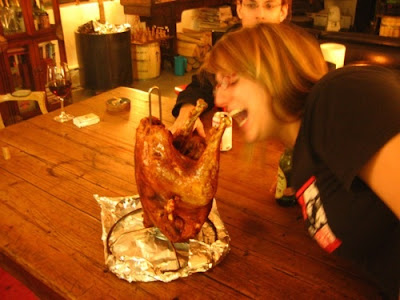.jpg)
My mouth is watering already. If you haven't had a chance to savor deep fried turkey here is a terrific recipe.
Texas Monthly
Featured in the November 1998 issue of Texas Monthly
Texas Deep-Fried Turkey
“I used to hate turkey because it’s always so dry,” says Grady Spears. But four years ago, the thirty-year-old chef had a change of heart: “That year we had Thanksgiving with True Redd, this artist who has a house on Caddo Lake, in East Texas. Everybody brought a dish, and True deep-fried a turkey. It was so moist that I just loved it.”
Equipment
1 turkey cooker with a propane burner (also called a catfish cooker or crawfish boiler)
1 36- to 40-quart stockpot and basket
1 large turkey injector with needle
1 deep-fryer thermometer or candy thermometer
elbow-length oven mitts
Cinnamon-Chile Rub
1/2 cup cinnamon
1/2 cup pasilla or other red chile powder
1/2 cup brown sugar
1/2 cup kosher salt
Combine all ingredients and mix well.
Turkey
4 to 6 gallons peanut oil (depending on size of stockpot and turkey)
3 1/2 cups chicken stock (two 14.5-ounce cans)
1/2 cup Tabasco sauce
1 turkey, 12 to 15 pounds (inside removed)
2 cups cinnamon-chile rub (recipe above)
Place the peanut oil in the stockpot on the turkey cooker and preheat to 350 degrees. Meanwhile, in a bowl combine the chicken stock and Tabasco. Place the turkey in a shallow pan or bowl. Fill the syringe with stock mixture, inject all parts of the turkey (legs, breast, thighs), and then thoroughly coat the outside of the turkey with the cinnamon-chile rub. When the oil reaches 350 degrees, place the turkey in the basket and, wearing oven mitts, carefully lower it into the stockpot. Cook for 3‡ minutes per pound (for example, a 12-pound turkey will be done in 42 minutes). Remove the turkey from the oil and drain well. Place it on your favorite platter and carve away.
Wet Noodle Posse
Texas Deep-Fried Turkey
(Most of you are thinking “Huh?” but trust me. Fried turkey is to die for and faster to cook than roasted or smoked turkey.)
1 (10- to 12-pound) turkey
2 teaspoons salt, or to taste
2 teaspoons pepper, or to taste
1 teaspoon cayenne pepper
4-5 gallons peanut oil
Rinse and dry turkey after removing innards from both ends. Generously season inside of cavity with spices. Heat oil to 350-375 degrees in an outdoor deep fryer. When oil is at the right temperature, use a strong twine or rope sling to lower the turkey into the fryer. (Wear goggles; this puppy may splatter.) Cook about five minutes per pound or until meat thermometer reaches 180 degrees.
For wild turkey, cook only four minutes per pound.
D’Agostino’s Supermarkets
Texas Deep-Fried Turkey
Our neighbors in Louisiana get the credit for Cajun-fried turkey, but Texans have embraced this cooking method as if it had come from deep in the heart. All the ingredients are there to make a Texan love it: The cooking is done outdoors, it requires special equipment, the turkey cooks fast, and it is fried.
Actually, anything as big as a turkey doesn’t exactly fry when immersed in hot oil; it boils. But the end result is a moist, tender bird with a golden skin. Done correctly, it is not greasy.
Like the smoked turkey, there are plenty of places to buy a Cajun-fried turkey in most major cities. Catfish restaurants particularly like to fry whole turkeys as a holiday sideline. But if you want to try it yourself, here’s how.
You’ll need an outdoor cooker, usually gas powered, with a cooking pot large enough to hold 4 or 5 gallons of peanut oil and a turkey. Catalogs for outdoor equipment as well as hardware and camping stores often carry turkey-frying kits, priced about $50. They are worth the investment because they include lifters to make removing the turkey easier and safer.
There are also injector kits with syringes to shoot marinade into the turkey meat before frying. Otherwise, ample seasoning with salt and pepper, perhaps some cayenne, inside the turkey will do nicely.
This is a particularly good technique for wild turkey, because it keeps the lean meat very moist. As always with wild game, avoid overcooking. And don’t let the scrawny appearance of the wild bird next to that plump domestic darling bother you. It doesn’t look like a textbook turkey, but it tastes great. Our neighbors in Louisiana get the credit for Cajun-fried turkey, but Texans have embraced this cooking method as if it had come from deep in the heart. All the ingredients are there to make a Texan love it: The cooking is done outdoors, it requires special equipment, the turkey cooks fast, and it is fried.
Actually, anything as big as a turkey doesn’t exactly fry when immersed in hot oil; it boils. But the end result is a moist, tender bird with a golden skin. Done correctly, it is not greasy.
Like the smoked turkey, there are plenty of places to buy a Cajun-fried turkey in most major cities. Catfish restaurants particularly like to fry whole turkeys as a holiday sideline. But if you want to try it yourself, here’s how.
You’ll need an outdoor cooker, usually gas powered, with a cooking pot large enough to hold 4 or 5 gallons of peanut oil and a turkey. Catalogs for outdoor equipment as well as hardware and camping stores often carry turkey-frying kits, priced about $50. They are worth the investment because they include lifters to make removing the turkey easier and safer.
There are also injector kits with syringes to shoot marinade into the turkey meat before frying. Otherwise, ample seasoning with salt and pepper, perhaps some cayenne, inside the turkey will do nicely.
This is a particularly good technique for wild turkey, because it keeps the lean meat very moist. As always with wild game, avoid overcooking. And don’t let the scrawny appearance of the wild bird next to that plump domestic darling bother you. It doesn’t look like a textbook turkey, but it tastes great.
Source - - The Big Apple
Image - [missginsu on Flickr]
By Little Baby Ginn
DBKP.com - Bigger, Better!
Back to Front Page.






























No comments:
Post a Comment
Leave your name/nic.
We've changed the comments section to allow non-registered users to comment.
We'll continue like that until it's being abused.
We reserve the right to delete all abusive or otherwise inappropriate comments.